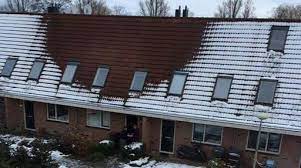What the Frost on your Roof Means

If your roof does not have frost on it while the surrounding environment is cold enough for frost to form, it could indicate several things:
-
Insulation and Ventilation: If your roof is well-insulated and properly ventilated, it may not accumulate frost as readily. Good insulation helps maintain a consistent temperature in your attic, preventing warm air from escaping and creating conditions for frost.
-
Sun Exposure: If your roof receives direct sunlight during the day, it may warm up enough to prevent frost formation. Sunlight can melt frost before it has a chance to accumulate.
-
Material and Color: The type of roofing material and its color can influence its ability to accumulate frost. Some materials retain heat better than others, and darker colors tend to absorb more sunlight, preventing frost buildup.
-
Wind Exposure: Wind can play a role in preventing frost on a roof. A windy environment may not allow frost to settle or accumulate on the roof surface.
-
Recent Snowfall or Precipitation: If there has been recent precipitation, such as snow or freezing rain, it may cover the roof and insulate it from the cold, preventing frost formation.
-
Humidity Levels: Low humidity levels in the air can also affect the formation of frost. If the air is very dry, frost may be less likely to form on surfaces.
It's important to note that the absence of frost on a roof doesn't necessarily indicate a problem. However, if you notice inconsistent patterns of frost or other unusual conditions, it might be worth investigating further, as it could be related to insulation issues, ventilation problems, or other factors that may impact the efficiency and integrity of your roofing system.
Contact us today at (412) 837-3064 or visit https://koalainsulation.com/pittsburgh to explore our insulation solutions and ensure your home remains a comfortable haven throughout the fall and winter.
Find Your Location


Get a quote


